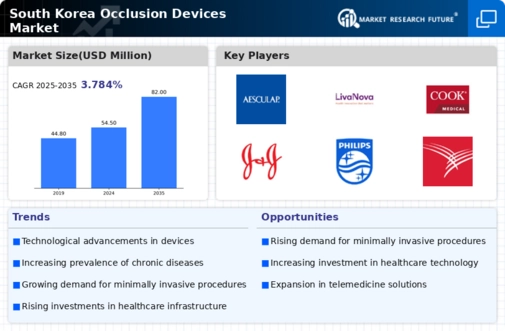Aging Population
The demographic shift towards an aging population in South Korea significantly influences the occlusion devices market. With an increasing number of elderly individuals, the prevalence of conditions requiring occlusion devices, such as cardiovascular diseases and stroke, is expected to rise. By 2025, it is estimated that over 20% of the South Korean population will be aged 65 and above, creating a substantial demand for medical interventions. This demographic trend suggests that healthcare providers will need to enhance their offerings, including occlusion devices, to cater to the specific needs of older patients. Consequently, the occlusion devices market is likely to experience growth as healthcare systems adapt to the challenges posed by an aging society.
Increasing Healthcare Expenditure
The rising healthcare expenditure in South Korea is a pivotal driver for the occlusion devices market. As the government and private sectors allocate more funds towards healthcare, the demand for advanced medical devices, including occlusion devices, is likely to increase. In 2025, healthcare spending in South Korea is projected to reach approximately $200 billion, reflecting a growth rate of around 5% annually. This financial commitment enables hospitals and clinics to invest in innovative occlusion devices, enhancing patient care and treatment outcomes. Furthermore, the emphasis on improving healthcare infrastructure and technology adoption supports the expansion of the occlusion devices market. As healthcare providers seek to offer better services, the integration of advanced occlusion devices becomes essential, thereby driving market growth.
Supportive Regulatory Environment
A supportive regulatory environment in South Korea is instrumental in fostering the growth of the occlusion devices market. The government has established frameworks that facilitate the approval and commercialization of new medical devices, ensuring that innovative products can reach the market efficiently. Regulatory bodies are increasingly streamlining processes, which encourages manufacturers to invest in research and development. This proactive approach not only enhances the availability of advanced occlusion devices but also instills confidence among healthcare providers and patients. As a result, the occlusion devices market is likely to benefit from this conducive regulatory landscape, promoting the introduction of cutting-edge technologies and improving patient care.
Technological Innovations in Medical Devices
Technological innovations play a crucial role in shaping the occlusion devices market. The continuous development of advanced materials and design improvements enhances the efficacy and safety of occlusion devices. In South Korea, research and development initiatives are increasingly focused on creating devices that offer better performance and patient outcomes. For instance, the introduction of bioresorbable occlusion devices is gaining traction, as they provide temporary occlusion without the need for surgical removal. This innovation aligns with the growing trend towards personalized medicine and tailored treatment options. As these technologies evolve, they are likely to attract investment and drive growth in the occlusion devices market, reflecting the dynamic nature of the healthcare landscape.
Rising Awareness of Minimally Invasive Procedures
There is a growing awareness and preference for minimally invasive procedures among both healthcare professionals and patients in South Korea. This trend is a significant driver for the occlusion devices market, as these devices are often integral to such procedures. The advantages of minimally invasive techniques, including reduced recovery times and lower risk of complications, are increasingly recognized. As a result, hospitals are more inclined to adopt occlusion devices that facilitate these procedures. Market data indicates that the minimally invasive surgery segment is expected to grow at a CAGR of 7% through 2025, further propelling the demand for occlusion devices. This shift in surgical practices underscores the importance of innovation in the occlusion devices market.

















Leave a Comment